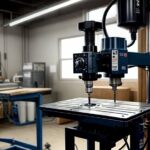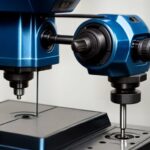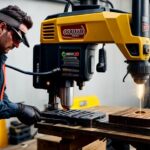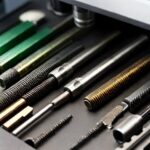A magnetic drill press may be a game changer when drilling through resistant materials like metal or concrete. In layman’s words, a specialized drilling instrument employs a strong magnet to keep the drill in position as it bores through the material. Its one-of-a-kind design allows you to drill through thick and irregular surfaces without worrying about the drill bit sliding or shifting.
A magnetic drill press often includes additional qualities that make it a versatile and dependable instrument in addition to its magnetic capabilities. It may, for example, feature an adjustable motor speed that lets you vary the drilling pace dependent on the material you’re dealing with. It may also have a coolant system to avoid overheating and increase the drill bit’s life.
What is a Magnetic or Mag drill press?
A magnetic drill press is a drilling instrument that employs a strong magnet to keep the drill in position while boring through resistant materials, including metal, concrete, and steel. The magnet establishes a strong and steady connection between the drill press and the workpiece, guaranteeing drilling accuracy and precision.
How does a Magnetic/Mag drill work?
- Place the magnetic drill press on the chosen workpiece position.
- Start the drill press and engage the magnet to form a strong bond between the tool and the workpiece.
- Set the drill bit to the depth and speed you want.
- Start drilling by lowering the drill bit onto the workpiece.
- Utilize the coolant system to keep the drill bit from overheating and prolong its life.
- After the drilling is finished, remove the drill press from the workpiece.
- Clean and maintain the drill press to guarantee optimal operation.
Types of Magnetic/Mag drill presses:
- Portable Magnetic Drill Press: Since it is lightweight and small, it is convenient for traveling to various work locations. It has a lower drilling capacity and is best suited for drilling tiny to medium-sized holes in metal and steel.
- Heavy-Duty Magnetic Drill Press: This magnetic drill press is intended for heavy-duty drilling applications such as drilling big-diameter holes in thick steel or concrete. It has a greater drilling capacity and is generally more powerful than a portable magnetic drill press.
- Electromagnetic Drill Press: An electromagnetic base positions the tool during drilling in this magnetic drill press. It is often used in the metal manufacturing and construction sectors for drilling through thick materials.
- Pneumatic Magnetic Drill Press: This form of magnetic drill press is typically used in industrial settings and is driven by compressed air. Its high drilling speed and accuracy make it suitable for drilling through hard and thick materials.
- Hydraulic Magnetic Drill Press: This magnetic drill press drives the drill with hydraulic power and is perfect for heavy-duty drilling activities. It can drill deeper and is often used in the construction, mining, and oil and gas sectors.
Advantages of using a Magnetic drill press:
- 1. Precision: Magnetic drill presses deliver precise and accurate drilling due to the magnet’s firm and secure connection between the tool and the workpiece. This enables more accurate and consistent holes while decreasing the possibility of errors or blunders.
- 2. Efficiency: Magnetic drill presses are more efficient than conventional drilling processes. Since the magnet can keep the tool in place, there is no need for clamps or other tools to secure the workpiece. Moreover, the variable motor speed and coolant system enable quicker and more efficient drilling, saving time and effort.
- 3. Versatility: Magnetic drill presses are adaptable instruments that may be utilized for various drilling tasks. They can drill through several materials, including metal, steel, and concrete, and are appropriate for small and large-scale drilling jobs.
- 4. Safety: Magnetic drill presses are typically safer than conventional drilling techniques since the drill bit is less likely to slide or move during drilling. Moreover, the cooling system prevents overheating and lowers the probability of an accident.
- 5. Economical: Although magnetic drill presses may be more expensive up front than conventional drilling techniques, they may save money in the long term by minimizing the need for extra tools and equipment and enhancing efficiency.
5 Components of a Magnetic Drill Press:
- The Base: The base of a magnetic drill press is normally built of strong material, such as steel, and serves as a firm platform for the tool when drilling. It is often equipped with movable feet that adjust it on uneven terrain.
- The Motor: The drill bit is powered by the motor, which may be changed for speed and torque to meet varied materials and drilling operations. A chuck or collet connects the motor to the drill bit, normally positioned at the base.
- Drill Bit: A drill bit is a cutting instrument that bores a hole through a workpiece. It is built of diverse materials and has various sizes and forms to meet varied drilling jobs. A chuck or collet connects the drill bit to the motor.
- The Magnet: The magnet is the most important component of a magnetic drill press because it offers a strong connection between the tool and the workpiece. It is normally found at the bottom and is controlled by a switch or lever.
- The Control Panel: Located on the drill press, the control panel enables the operator to regulate the motor speed, monitor the drilling process, and activate the coolant system. It often incorporates buttons, switches, and gauges that give drilling process information.
How to Choose the Right Magnetic Drill Press?
- Drilling Capacity: A magnetic drill press’s drilling capacity refers to the largest hole size it can drill into the workpiece. Be sure to choose a drill press with a capacity corresponding to your unique drilling requirements.
- Motor Power: The motor’s power influences the drill’s speed and torque. Assess the materials you will be drilling and choose a motor with sufficient power to do the task.
- Speed Control: Managing the drill’s speed provides for more accurate drilling and may help prolong the life of the drill bit. Seek a magnetic drill press with a variable-speed motor.
- Coolant System: A coolant system keeps the drill bit from overheating and extends its life. Choose a magnetic drill press that has a dependable and efficient coolant system.
- Portability: If you use the drill press in many places, look for a portable type that is simple to transfer.
- Cost: Magnetic drill presses may cost anything from a few hundred to several thousand dollars. Assess your budget and choose a drill press with the features and capabilities you want at an affordable price.
- Brand Reputation: Choose a magnetic drill press from a recognized company that provides dependable customer service and warranty choices.
Frequently Asked Questions (FAQs)
1. Can a magnetic drill press be used on non-magnetic materials?
A magnetic drill press relies on its magnetic base to secure the tool to the workpiece, so it is best suited for drilling into magnetic materials like steel and iron. However, you can use a magnetic drill press on non-magnetic materials by using clamps, jigs, or fixtures to secure the workpiece and the drill press.
2. Can I use regular drill bits with a magnetic drill press?
Magnetic drill presses typically use annular cutters, which are specifically designed for drilling through metal and steel. However, some magnetic drill presses come with adapters that allow you to use standard twist drill bits. Check the manufacturer’s specifications to determine whether your magnetic drill press is compatible with regular drill bits.
3. How do I maintain my magnetic drill press?
Proper maintenance of your magnetic drill press is essential for ensuring its longevity and optimal performance. Some maintenance tips include:
– Regularly clean the drill press, removing any dust or debris.
– Check the drill bit for wear and replace it when necessary.
– Lubricate moving parts to prevent friction and wear.
– Inspect the electrical components for any damage or wear.
– Use the coolant system as recommended to prevent overheating.
4. Do I need any special safety gear when using a magnetic drill press?
When using a magnetic drill press, it’s essential to wear appropriate safety gear to protect yourself from potential hazards. Some safety gear you should use includes:
– Safety glasses or goggles to protect your eyes from flying debris.
– Ear protection to reduce noise exposure.
– Gloves to protect your hands from sharp edges and hot surfaces.
– Proper footwear with non-slip soles to prevent slips and falls.
5. How do I ensure accurate drilling with a magnetic drill press?
To ensure accurate drilling with a magnetic drill press, follow these steps:
– Ensure the workpiece is clean and free of any debris.
– Mark the drilling location accurately on the workpiece.
– Position the magnetic drill press correctly, ensuring it is aligned with the marked drilling location.
– Engage the magnet to secure the drill press to the workpiece.
– Set the drill bit depth and speed according to the material and desired hole size.
– Start drilling, applying even pressure and using the coolant system as needed.
Final word:
A magnetic drill press is a drilling instrument that employs a strong magnet to keep the drill in position as it bores through resistant materials. Its unique design enables accurate and efficient drilling, making it a vital tool for pros and DIY enthusiasts.
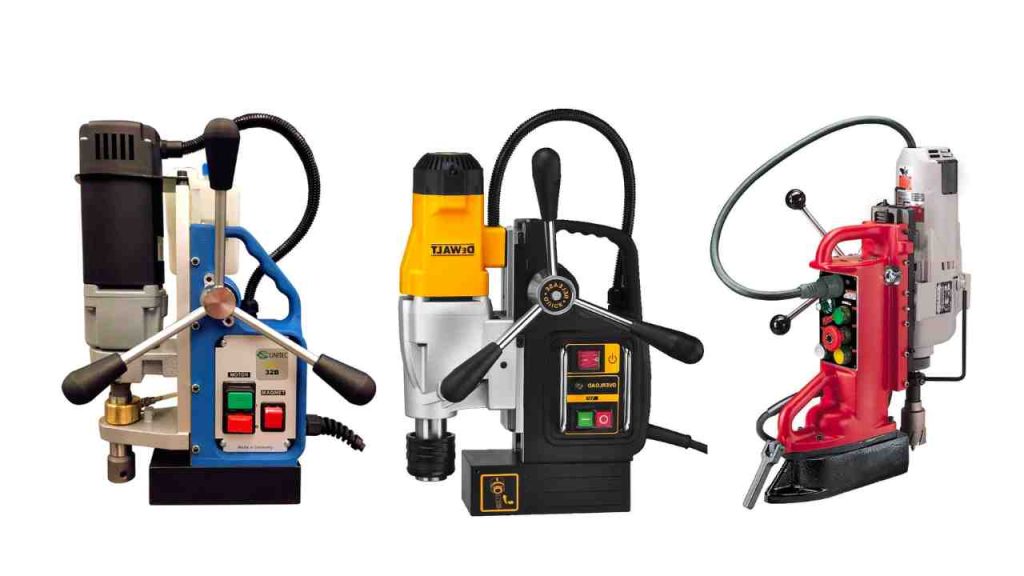 Magnetic drill presses are available in various configurations, each tailored for a particular drilling purpose. Consider variables such as drilling capacity, motor power, speed control, coolant system, mobility, pricing, and brand reputation when purchasing a magnetic drill press.
Magnetic drill presses are available in various configurations, each tailored for a particular drilling purpose. Consider variables such as drilling capacity, motor power, speed control, coolant system, mobility, pricing, and brand reputation when purchasing a magnetic drill press.
- Where are WEN drill presses made? - April 2, 2023
- Where are Rikon drill presses made? - April 1, 2023
- Where are Powermatic drill presses made? - April 1, 2023


